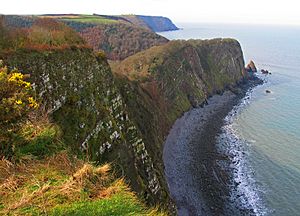North Devon Coast facts for kids
The North Devon Coast is a very special part of England. It was officially named an Area of Outstanding Natural Beauty (AONB) in September 1959. This means its amazing landscape is protected so everyone can enjoy it.
The North Devon Coast AONB covers about 171 square kilometers (66 square miles). It stretches along the coast from Exmoor National Park near Combe Martin. It goes past the mouth of the Taw & Torridge Estuary all the way to the Cornish border at Marsland Mouth. The huge sand dune system at Braunton Burrows is a key part of this area. It's even the core of North Devon's Biosphere Reserve, which is a special place recognized by Unesco for its unique nature. The entire AONB is inside this important Biosphere Reserve.
Contents
How the North Devon Coast Became Special
People started thinking about protecting the North Devon Coast way back in 1953. At first, they thought it might become part of the Exmoor National Park. But that didn't happen. By 1956, the Devon County Council decided that both the North and South Devon Coasts should become AONBs.
The National Parks Commission (now called Natural England) helped draw up the boundaries. They talked to local councils and people. For example, they first thought about leaving out part of Combe Martin village because of power lines. But after more discussions, they included areas like Northam Burrows. Finally, in September 1959, the North Devon AONB was officially named. It was the first AONB in Devon!
For many years, the AONB didn't have its own special team to look after it. But in the early 1990s, a Heritage Coast Service started helping. In 2002, Braunton Burrows became the core of a Biosphere Reserve. This gave the area international recognition for its importance to nature. Soon after, in 2004, the North Devon AONB Partnership was created. This group works closely with the UNESCO Biosphere Reserve team to protect and manage this beautiful coast.
Exploring the North Devon Coast Landscape

The North Devon AONB has a huge variety of amazing scenery. You can find tall, rugged cliffs, wide sandy beaches, and impressive sand dunes. There are also traditional fields with wind-shaped trees, steep wooded valleys, and even forests that reach right to the cliff edge!
This special area includes the dramatic coastline of the Hartland promontory. You can also find the peaceful Bideford Bay, and the very important nature sites around the Taw and Torridge Estuary. The striking headlands and golden beaches of the North Devon Downs are here too. Plus, there are hidden coves and bays along the North Devon High Coast. The North Devon coastline faces the Atlantic Ocean and the Bristol Channel.
Experts have studied the landscape of the North Devon AONB. They have divided it into 11 main types of scenery. Here are a few examples:
Open Coastal Plateaus
These are flat, open areas found along the Atlantic Coast. They have low hedges and few trees. You can get amazing long views along the coast from these spots.
Farmed Lowland Moorland
This type of landscape is found inland from Hartland Point. It's very flat and has lots of farmland, often with conifer tree plantations. There are also areas of open moorland.
Scarp Slopes
These are narrow, steep valleys, often with thick woodlands. They are very quiet and remote, with limited roads.
Settled Coastal Slopes and Combes
These areas have steep, narrow valleys with a mix of woodlands and small fields. They often have villages and towns built into the slopes, especially around Ilfracombe and Clovelly.
Steep Open Slopes
These are west-facing hillsides near sandy beaches, like between Morte Point and Braunton. They are open farmlands with low hedges and offer wide coastal views.
Coastal Dunes
These are the huge sand dune systems found along the north-western Devon coast, next to the beaches. They are incredibly important for wildlife and are recognized internationally for their biodiversity.
Cliffs
Along the north and west coasts, you'll find tall, steep cliffs. These areas are mostly unsettled and can be hard to reach. They often have small shingle beaches or rocky shores at their base. You can walk along the cliff tops on the South West Coast Path and enjoy amazing views.
Wildlife of the Coast
The North Devon AONB is home to a fantastic variety of wildlife. It has different habitats like the grassy areas around Hartland, the coastal woodlands near Clovelly, and the heathlands around Hartland and Morte Point. The huge sand dunes at Braunton and Northam Burrows are also very important.
You can find beautiful orchids in the sand dunes and bluebells in the coastal valleys. Many different birds and insects live in the coastal heaths. These varied habitats support a rich mix of plants and animals. The AONB also has many historic sites and old field patterns that show how people have lived here for thousands of years.
People and Work on the Coast
About 12,000 people live within the AONB. The biggest villages are Combe Martin and Hartland. Other well-known and picturesque villages include Clovelly, Berrynarbor, and Croyde. Larger towns like Ilfracombe, Bideford, and Braunton are just outside the AONB. They act as "gateway" towns, helping visitors explore the area.
The main ways people make a living in the AONB are through farming and tourism. These activities have greatly shaped the beautiful landscape you see today.

